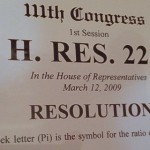 U.S. House Resolution 224 (March 2009)
U.S. House Resolution 224 (March 2009)
» Congress votes, not quite unanimously, to recognize March 14 as Pi Day
Only 112 years after its last appearance on a legislative floor—the doomed bill in the Indiana statehouse that offered nine different values for the number—Pi made a surprise appearance in the U.S. House of Representatives in 2009.
March 14 fell on a Saturday in 2009, but that didn‘t stop things from heating up in the week leading up to it. On Monday, March 8th, Representative Bart Gordon of Tennessee introduced House Resolution 224, officially called “Supporting the designation of Pi Day, and for other purposes.” As the chairman of the House Committee on Science and Technology, Gordon’s intent was clear: to use the holiday as a platform for making a statement about the importance of math and science education in America.
Gaining Momentum
After emerging from Gordon’s committee, the bill was managed on the floor by another Tennesseean, Rep. Lincoln Davis. For 14 minutes on the morning of March 11th, Davis and his colleague Paul Broun (Georgia) spoke passionately on the House floor in support of Pi Day and what it stands for. Davis’ message was clear: “I’d like to take this opportunity to encourage our Nation’s students of all ages, schools, and teachers, to observe Pi Day with fun math and science activities and events.”
“I leave the specifics to the schools, but my advice is to go and have some fun,” he continued. “Let the students see firsthand how math and science is fun and relevant. Let them see that it does apply to them. Let them discover that they really do like math and they really do like science.”
The resolution was co-sponsored by 15 other House members from across the country, including the exuberant Brian Baird (Washington). “I’m kind of geeked up about it,” Baird told a reporter. “It’s crazy, but I’m a whole lot more excited about that than congratulating the winner of last year’s Rose Bowl.” In order to pass, the resolution needed “Aye” votes from two-thirds of the chamber. The vote was conducted by voice, and everyone was for it. Well, almost everyone.
Not Quite Unanimous
A handful of “Nays” were heard across the room, so Davis called for a roll-call vote to put everyone’s stance on the record. The matter was tabled, and everyone had the night to mull it over. The next afternoon, on March 12, the votes were tallied and the verdict was in: 391 to 10. So, you ask, there were ten elected officials who didn’t like the idea of making math and science fun? Who were these people?
Chaffetz, Jason, R-Utah, 3rd
Flake, Jeff, R-Arizona, 6th
Heller, Dean, R-Nevada, 2nd
Johnson, Timothy V., R-Illinois, 15th
Miller, Jeff, R-Florida, 1st
Neugebauer, Randy, R-Texas, 19th
Paul, Ron, R-Texas, 14th
Pence, Mike, R-Indiana, 6th
Poe, Ted, R-Texas, 2nd
Shuster, Bill, R-Pennsylvania, 9th

Rep. Jason Chaffetz (UT)
Two of these dissenters deserve a closer look. One was the brand new Utah Congressman Jason Chaffetz, who was fond of keeping in touch with his constituents via Twitter. Over the course of that week, Chaffetz posted no fewer than 13 tweets about the pending Pi Day vote. He was clearly undecided, sometimes praising it and at other times mocking it. He even asked his supporters for their input:
In the end, after much deliberation, Jason Chaffetz voted against it. His stated rationale was admittedly clever:
And if Chaffetz’s wavering wasn’t enough, there was one other Congressman who added to the unexpected (hint of) drama. Mike Pence, now the nation’s Vice President, was part of the overwhelming majority supporting Pi Day—that is, until the very last moment. The record shows that after 15 minutes of open voting, viewable on C-SPAN at the time, Pence changed his vote to become the 10th “Nay.” What makes this act the perfect ending to the latest chapter in Pi’s colorful history? Mike Pence was a representative of the great state… of Indiana.
Additional Resources:
Full text of U.S. House Resolution 224
Full text of the Floor Debate, March 11, 2009
Rep. Chaffetz’s Complete Pi Day Tweets (screen shots), March 2009



